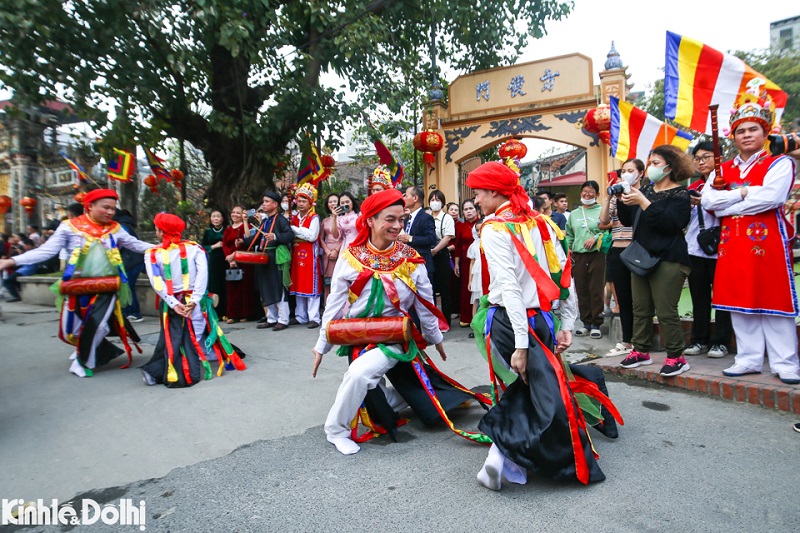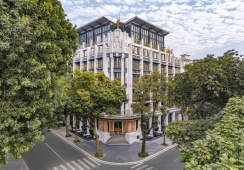
As one of the country's most priceless cultural legacies, the ancient Thang Long dances have been painstakingly preserved by local artists in the hope that future generations will carry on the tradition.
| Folk dance performed by local artists in Trieu Khuc village. Photo: Ngoc Tu/The Hanoi Times |
The ancient village of Trieu Khuc, which now covers parts of both Thanh Xuan and Thanh Tri districts, is home to the Con di danh bong (Flirtatious girls playing tom-tom) folk dance.
The dance dates back to the eighth century. Legend has it that a king held a ceremony in the village on the ninth day of the first lunar month to prepare for the final battle against the invaders.
The king introduced a dance performance in which men dressed as women to encourage and motivate his soldiers.
In Le Mat Village, Viet Hung Ward, Long Bien District, from the 20th to the 23rd day of the third lunar month, residents perform their Giao long (Kill the River Dragon) dance.
The purpose of the performance is to honor a man who killed the river monster to save a princess, brought peace to the area, and founded the village. He was then worshipped as the guardian of the village.
These are two of the few folk dances preserved in Hanoi.
Artist Nguyen Van Bich, former president of the Hanoi Dance Artists Association, said that the idea of collecting and preserving the ancient dances of Thang Long-Hanoi was born in 2000.
However, it was not until 2005 that the artists launched a project to study and compile the ancient dances of Thang Long-Hanoi.
"A low budget and aging couldn't stop them from preserving the dances," Bich said.
According to Bich, more than 50 dances have been collected and eight have been restored and filmed, including the two dances mentioned above.
In addition to the restoration of folk dances, the Hanoi Dance Artists Association has organized four festivals in 2007, 2008, 2009, and 2013, as well as two major folk dance events, each of which brought together more than 800 dancers and artists.
However, the work is becoming increasingly difficult as many of the elders who studied and knew how to dance have passed away, while the younger generations are not interested in preserving local traditions.
The collection and preservation of ancient dances are also challenged by the rapid urbanization process of the capital city.
Great efforts by locals
In 1985, realizing the possibility of losing the dance forever, artist Trieu Dinh Hong from Trieu Khuc Village founded a new club to preserve the custom.
| The "Kill the River Monster" dance in Le Mat Village, Long Bien District. Photo: The Hanoi Times |
The club has about 30 members. They are often present at the village's ceremonial rituals and participate in cultural events in the district and the city.
Club president Nguyen Huy Tuyen, 46, said Hong taught him how to move, swing his hands, and make eye contact from the very beginning.
"At first, we were embarrassed in front of the villagers and guests. We wanted to quit," said Tuyen, referring to having to dance in a woman's dress in front of thousands of people.
"But Hong told us to go on and keep the traditions alive. Now we are all proud of it."
According to folk artist Nguyen Ngoc Anh, President of the Hanoi Dance Artists' Association, it is important to collect, preserve, and educate young people about the ancient dances of Thang Long-Hanoi.
"We plan to introduce local folk dances to locals and visitors arriving in the capital," he said.
Anh added that the association will continue to compile ancient dances in Hanoi and organize training and performance events.
"The association will work with the Hanoi Department of Education to teach ancient dance in schools," he said.
The association also expects to cooperate with the Vietnam National Authority of Tourism to launch a new product with Thang Long-Hanoi ancient dance as its core, the president said.
People's Artist Ung Duy Thinh suggested that the activities of the association, local authorities, and local clubs should involve professional art agencies to make groundbreaking steps.
He advised that dance artists and researchers cannot do their work alone, and the combination with such agencies will give a great boost to Vietnam's and Hanoi's cultural industries.
Thinh noted that relevant parties must be careful when incorporating ancient dances into modern plays so as not to tweak the traditions too much.
Meanwhile, Dang Chi Thong, an expert on ancient dances, suggested that more art events should be held between Hanoi and other localities and even other nations in order to popularize Thang Long-Hanoi ancient dances and motivate local artists to preserve them.



